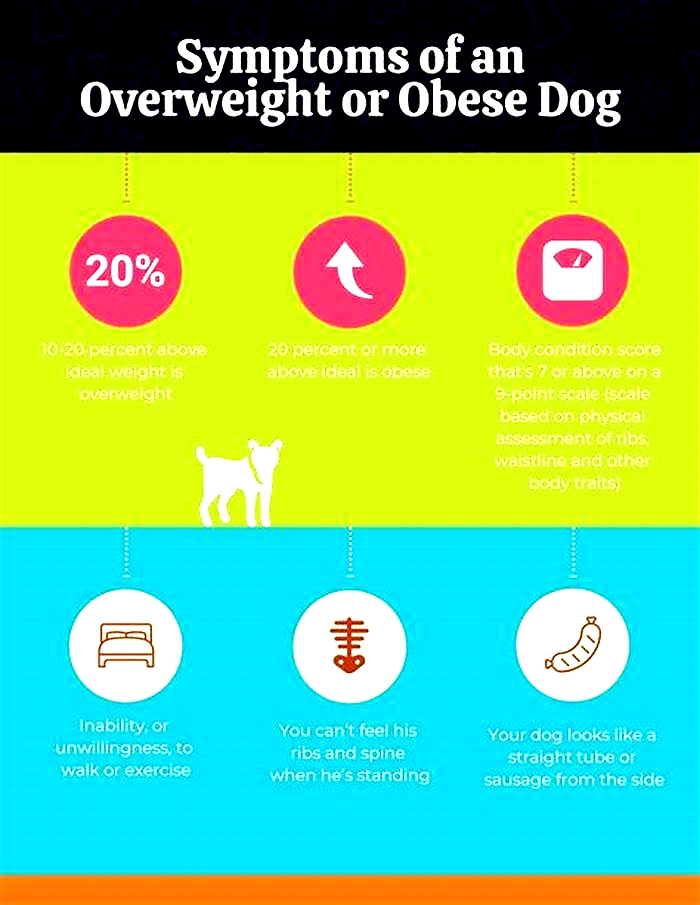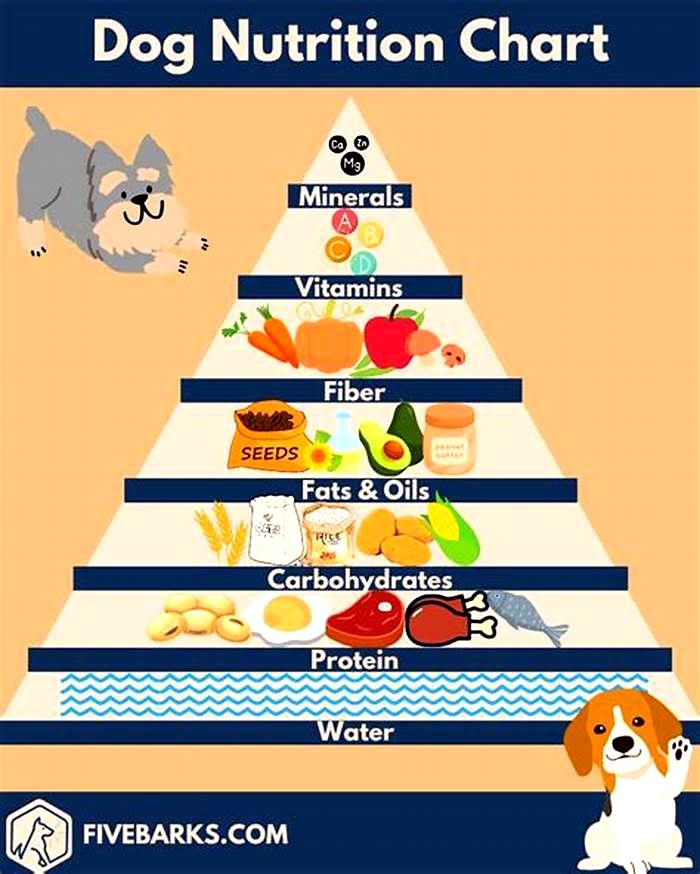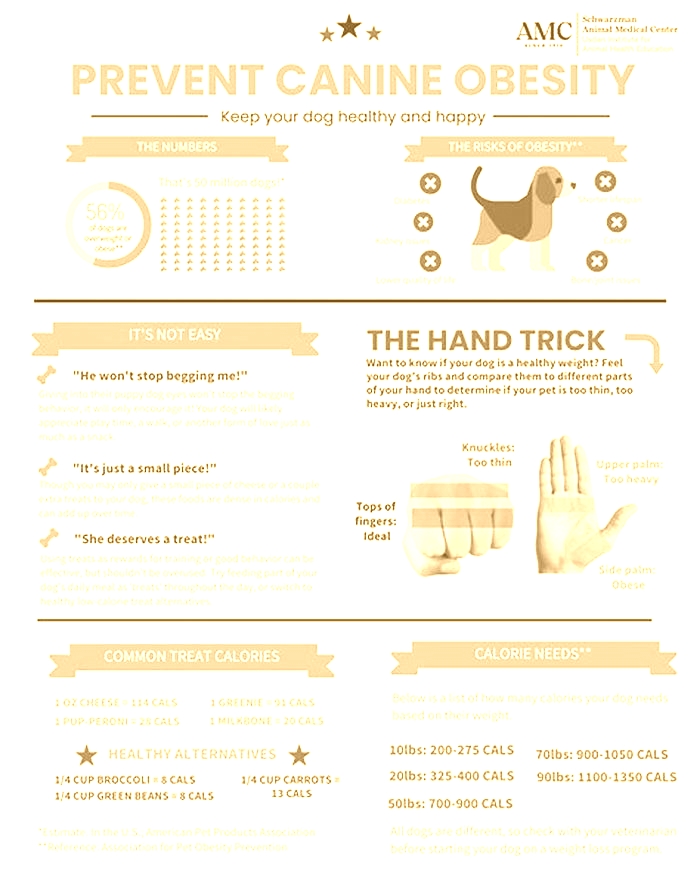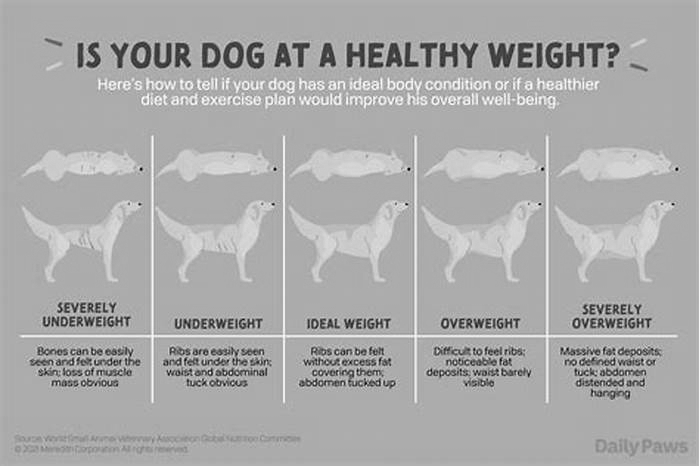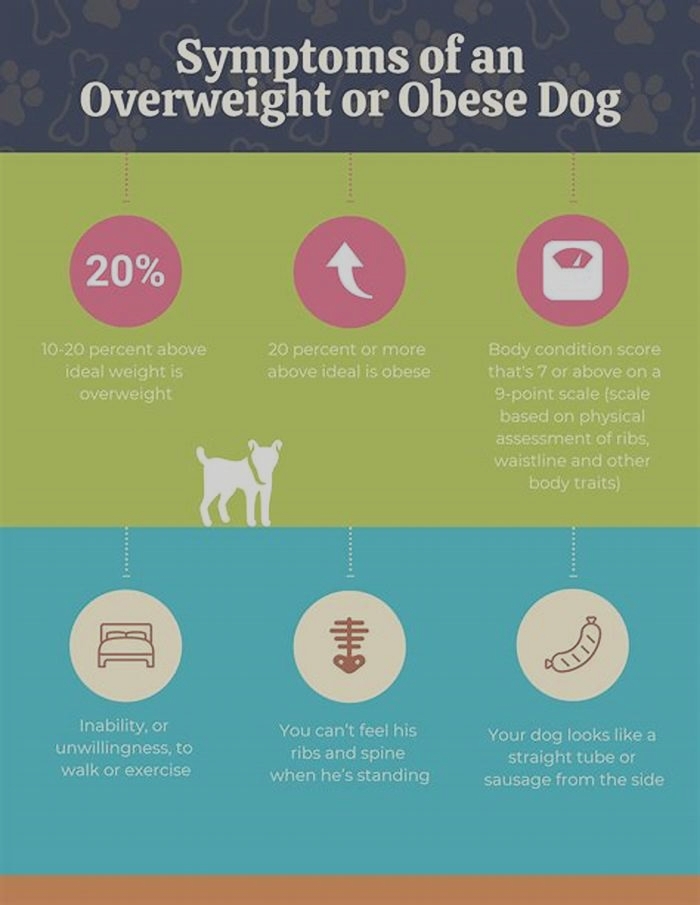The Importance of a Nutritious Diet in Managing Canine Obesity Tips for Success

Obesity
A common problem in dogs
Obesity, or excessive body fat resulting in an overweight condition, is sadly an extremely common and preventable problem affecting our pets, with more and more cases seen every year. In fact, canine obesity is the most common nutritional disorder seen in dogs. As with humans, it's caused by an imbalance of taking in more energy than giving out.
How to know if your dog is overweight
Signs your dog is overweight include:
- owners struggling to see or feel their dog's ribs, spine or waistline
- abdominal sagging
- a bigger, rounder face
- a reluctance to go for walks or lagging behind
- excessive panting
- tiredness
- needing help getting in and out of cars
- a refusal to move or play games
Problems associated with obesity
Vets see these problems all too often, with obese pets posing greater risks from anaesthetic and surgical complications, heat or exercise intolerance, complications from cardio-respiratory disorders, hormone problems, skin disease, cancer and urogenital disorders even early death. Canine obesity may even contribute to tracheal collapse and laryngeal paralysis too.
Common canine problems suffered as a result of obesity include:
- Diabetes - where the pancreas fails to secrete enough insulin in order to regulate blood glucose levels
- Heart disease - caused by high cholesterol levels
- Arthritis - directly affecting mobility, making it even harder for your pet to lose weight
The dangers of fat
Until fairly recently, fatty tissue was thought to be just a relatively lifeless energy store and insulator; but we now know it secretes hormones affecting appetite, inflammation, insulin sensitivity and bodily function, as well as influencing water balance and blood pressure, leading to kidney disease and high blood pressure.
Factors contributing to canine obesity
Excess energy is stored primarily as fat but many other factors also contribute to canine obesity including age, sex, reproductive status, inactivity, owner's decisions on dog's food intake, diet and palatability, environment, lifestyle, and any underlying disease that impairs exercise and results in excessive weight gain. Some breeds appear to have a higher incidence of obesity, indicating that genetics may play a major part, with unneutered adult dogs often weighing less than neutered dogs of the same breed too.
Neutering
Neutering is usually carried out at a young age - the same time as a natural decrease in growth and energy needs. Oestrogen also slows down fat production, with predictably decreased levels post spaying, so owners who are unaware of this change and continue to feed their pets the same amount of food will usually see a weight gain in their dog.
Age
Like us, ageing dogs become less active, needing less daily energy too. So it's no surprise that if food intake is not decreased proportionately, they can easily pile on the pounds.
Table scraps
Feeding table scraps and other fatty treats may encourage many pets to overeat and gain excessive weight. In some adult dogs, up to half the calories they need are supplied as human food, particularly in toy breeds.
Not measuring out food
Surprisingly, some owners are still unsure about how much to feed their dog, failing to measure food accurately, and sometimes in denial about how much they feed. The size of cup used to measure dry food and the size of bowl used for feeding also affect the amount of food fed to a dog; with owners given a large cup and bowl often providing more food than when a small cup and bowl are used.
Eating with other dogs
The social setting of meals can also influence eating behaviour, with most dogs increasing their food intake when eating alongside other pets in what's known as 'social facilitation'. That said, being an 'only dog' has also been associated with the risk of obesity, which is probably due to being spoilt rotten by its owners.
Ways to prevent obesity
If your dog is overweight, then carefully start changing their feeding habits by:
- increasing exercise (e.g. taking more frequent or longer walks, or taking up a canine activity such as agility or flyball)
- looking at the type of food they eat, as well as their intake:
- create a feeding plan
- incorporate regular visits to your vet for weight loss advice and to have free weight checks
- record your success
Diet
Diets rich in protein and fibre but low in fat are typically recommended for weight loss, as it gives the dog the feeling of being full, but also provides them with more energy. Replacing traditional treats with carrot sticks is a great, healthy way to start. Ensure every family member is given their own pet feeding instructions and never leave any food lying around.
When to feed
Divide your dog's daily amount into several meals and try not to feed them too late, as they won't burn many calories when sleeping.
New foods
Remember, when introducing a new food, do it gradually over a seven-day period, mixing new food with the old, and always check the daily recommended amount.
Don't give scraps
Avoid feeding any leftovers or scraps from the table.Always check the daily recommended feeding guide on the packaging and weigh out the daily amount at the beginning of the day. You can then give 'treats' from this amount during the day, so you don't overfeed.
Speak to your vet
When your animal starts to lose weight, you will notice they are happier, more inclined to exercise, and have a lot more energy. So don't hesitate to book an appointment with your vet for advice and a healthy eating plan to help your dog battle the bulge.
Article author
This article was written byMarc Abraham, a vet based in Brighton who regularly appears on UK television.
Think your dog may be affected?
If you're worried about your dog's health, always contact your vetimmediately!
We are not a veterinary organisation and so we can't give veterinary advice, but if you're worried about any of the issues raised in this article, please contact your local vet practice for further information.
Find a vet near you
If you're looking for a vet practice near you, why not visit the Royal College of Veterinary Surgeons'Find a vetpage.
DIETARY MANAGEMENT OF OBESITY: CORNERSTONES OF HEALTHY EATING PATTERNS
SYNOPSIS
A number of dietary patterns, both macronutrient and food based, can lead to weight loss. A key strategy for weight management that can be applied across dietary patterns is to reduce energy density. Clinical trials show that reducing energy density is effective for weight loss and weight loss maintenance. A variety of practical strategies and tools can help facilitate successful weight management by reducing energy density, providing portion control, and improving diet quality. The flexibility of energy density gives patients options to tailor and personalize their dietary pattern to reduce energy intake for sustainable weight loss.
Keywords: WEIGHT MANAGEMENT, DIETARY STRATEGIES, ENERGY DENSITY, SATIETY, DIETARY PATTERNS
Introduction
The recent surge in rates of obesity is driven by eating behaviors and food choices that promote excessive energy intake.18 Current recommendations for weight management emphasize the importance of healthy eating patterns that include a variety of nutrient-dense foods, limit portions of energy-dense foods, and reduce overall energy density.8 A number of dietary patterns that reduce energy intake in relation to energy expenditure lead to similar weight loss. A unifying factor for weight loss across dietary patterns is energy density. Reducing a diets energy density allows individuals to consume satisfying amounts of food for fewer calories. Strategies that lower energy density are flexible and can be applied to multiple dietary patterns to match differences in energy needs, taste preferences, eating behaviors, food accessibility, and cultural backgounds.8,9 This article will discuss current evidence related to dietary approaches for weight management, and will provide strategies and tools to create lower-energy-dense eating patterns that can be tailored to the individual to achieve a sustainable and healthy weight management program.
Current Evidence on Dietary Patterns for Weight Loss
Macronutrient patterns for weight loss
Advice to alter the proportion of the macronutrients consumed has been the foundation for many weight loss diets.10 Fat, carbohydrate, and protein have all been highlighted at different times as the key to weight loss.1113 There continues to be controversy over whether a low-fat or low-carbohydrate diet is better for weight loss, or whether the increased satiating effects of a higher-protein diet help to sustain weight loss.10,14 An evidence-based report from the American College of Cardiology/American Heart Association Task Force on Practice Guidelines and The Obesity Society supports several energy-restricted dietary approaches for weight loss that focus on the macronutrients, including low-fat, lower-carbohydrate, moderate- and higher-protein, and macronutrient-targeted diets.15 While such diets can be effective, a number of systematic studies indicate that focusing on a particular macronutrient for weight loss is not necessary. Different macronutrient recommendations have all led to similar clinically significant weight loss at six months, one year, and even two years.12,16,17
One large clinical trial that compared four diets with different proportions of macronutrients, The Preventing Overweight Using Novel Dietary Strategies (POUNDS LOST) study, found that weight loss was similar across the diets (See ).12 While the macronutrient composition did not affect weight loss or maintenance of lost weight, regression analysis showed that reductions in dietary energy density and increases in fiber intake were strong predictors for six-month weight loss in all diet groups.1820 The fundamental dietary advice given to participants on all diets included strategies to lower the energy density of the diet, such as increasing vegetable and fruit consumption and decreasing consumption of high-calorie foods.12,21 These results suggest that regardless of macronutrient composition, a goal for weight loss should be to adopt a pattern of eating that is lower in energy density.
Weight loss over 2 years in adults assigned to 1 of 4 diets with different proportions of Carbohydrate/Protein/Fat as listed. There was no significant difference in weight loss related to the macronutrient composition.
Data from Sacks FM, Bray GA, Carey VJ, et al. Comparison of weight-loss diets with different compositions of fat, protein, and carbohydrates. N Engl J Med 2009; 360(9):859873.
Food-based patterns for weight loss
In recent years, dietary guidance has emphasized the importance of considering whole diets and patterns of consumption rather than a reductionist approach that focuses on single foods or nutrients.22 For example, the 2015 Dietary Advisory Committee recommends that individuals who have overweight and obesity achieve weight loss by adopting a healthy eating pattern. Examples of such patterns are the Healthy U.S.-Style Eating Pattern, which represents the Dietary Approaches to Stop Hypertension (DASH) diet, and the Healthy Mediterranean-Style Eating Pattern.8 The DASH eating pattern recommends reducing intake of the less healthy fats and keeping total fat intake to less than 25% of the diets energy, as well as increasing the proportion of low-energy-dense foods, such as vegetables and fruits (9 to 12 servings/day) and low-fat dairy products (2 to 3 servings/day).23 The DASH diet is a lower-energy-dense pattern of eating that allows individuals to consume less energy without reducing the weight of food they typically eat.24 The Mediterranean eating pattern also emphasizes intake of low-energy-dense fruits, vegetables, legumes, seafood, and dairy foods.25 However, higher amounts of fat (3040% of total energy), especially from olive oil, are recommended with the Mediterranean pattern.25 Even with this level of healthy fats, the high proportion of vegetables and fruits included in this pattern can help to keep the overall diet relatively low in energy density.26 provides guidance on food groups and amounts in several healthy eating patterns.
Table 1
Recommended daily amounts of food from each food group for the US Healthy Eating Pattern (DASH) and the Mediterranean Eating Pattern at two calorie levels
| Healthy US-StyleEating Pattern | Healthy Mediterranean-StyleEating Pattern | |||
|---|---|---|---|---|
| 1400 calories | 1800 calories | 1400 calories | 1800 calories | |
| Food Group | Daily amount from each food group | |||
| Vegetablesa | 1 cups | 2 cups | 1 cups | 2 cups |
| Fruitsb | 1 cups | 1 cups | 1 cups | 2 cups |
| Grainsc | 5 oz | 6 oz | 5 oz | 6 oz |
| Dairyd | 2 cups | 3 cups | 2 cups | 2 cups |
| Protein Foodse | 4 oz | 5 oz | 4 oz | 6 oz |
| Oils | 17 g | 24 g | 17 g | 24 g |
The influence of energy density on weight management
A key question is whether shifting to a healthy eating pattern that encourages individuals to lower the energy density of their diet will facilitate weight management.24,27 This was examined in the large multicenter PREMIER trial in which three intervention groups received information on diet and weight loss, with one group counseled to consume the DASH dietary pattern. Despite differences in treatment, after six months, all three groups experienced similar weight loss. While the average change in energy density of the three groups was similar, there was considerable variability within groups, making it possible to determine whether changes in energy density were related to weight loss. In a secondary analysis that combined the participants from all three groups, results showed that participants with larger reductions in dietary energy density lost more weight than those who had smaller reductions in energy density.24 Furthermore, those who had large or moderate reductions in energy density consumed a greater weight of food and improved diet quality by increasing vegetable and fruit consumption.24 Thus, the adoption of strategies that lowered energy density had a greater impact on weight loss than the specific dietary advice given to the three intervention groups.
Other clinical trials confirm that a lower-energy-dense eating pattern is an effective strategy for weight management.28,29 In one trial that compared the incorporation of either a low-or high-energy-dense food into a reduced-calorie diet, the reduction in dietary energy density was the main predictor of weight loss during the first two months of the study.28 Over the year of the trial, the daily consumption of the low-energy-dense food (soup) instead of higher-energy-dense dry snacks with the same calorie content increased the magnitude of weight loss.28 Encouraging regular consumption of low-energy-dense foods can reduce overall dietary energy density and can be an effective strategy for weight management.
Another clinical trial further explored the effectiveness of reducing energy density for weight management by comparing two energy density reduction strategies: reduced-fat or reduced-fat plus increased low-energy-dense vegetables and fruits.29 There were no specific goals for energy intake. After one year, participants in the group focused on eating more vegetables and fruits lost more weight, had a lower dietary energy density, consumed a greater weight of food (especially vegetables and fruits), and reported less hunger compared to participants focused just on fat reduction.29 An increase in the amount of food consumed when managing energy intake will likely improve the long term acceptability of a low-energy-dense eating pattern since it could help to control hunger.
Lowering dietary energy density can also help patients maintain their weight loss.30,31 In a clinic-based weight loss program that encouraged consumption of low-energy-dense foods, individuals who maintained their weight loss after two years reported eating a lower-energy-dense diet than those who regained 5% or more of their body weight.32 In another trial, instruction on reducing dietary energy density led to sustained weight loss 36 months after the start of the intervention.33
Patients need education on implementing changes in their diet to lower energy density and replicating this in their personal food environment.33 The strategies individuals use to reduce energy density can fit with a variety of healthy dietary approaches that are popular for weight loss. The next section focuses on dietary energy density, with more in-depth discussion of evidence-based principles that individuals can use to lower energy density and create sustainable eating patterns for weight management.
Unifying principle of dietary patterns: energy density
The energy density of a food or beverage can range from 0 calories per gram to 9 calories per gram, and varies based on the proportions of water (0 calories per gram), fiber (2 calories per gram), carbohydrate (4 calories per gram), protein (4 calories per gram), alcohol (7 calories per gram) and fat (9 calories per gram). Fat is the most energy-dense macronutrient, so when the fat content of a food is reduced, energy density also decreases. Water, however, has the biggest influence on energy density since it adds weight to food without adding calories. The more water a food contains, regardless of the fat content, the lower the energy density of the food. Low-energy-dense foods can help to reduce energy intake by enhancing satiation and satiety through psychological and physiological mechanisms. This leads to terminating a meal sooner, prolonging the time until the next eating occasion, and reducing intake at the next meal.34,35
The energy density of a food or beverage determines the portion size that can be eaten for a given number of calories: the lower the energy density, the larger the portion for the same number of calories. provides a visual example of how the portion size of a 100-calorie snack can vary based on the energy density of the food. For instance, a 100-calorie portion of raisins is about cup, while the same 100-calorie portion of cherry tomatoes is around 4 cups. As seen in , energy density can be explained visually to patients to help them understand the relationship between energy density and the portions that can be consumed. To help further understand this concept, energy density can be divided into four categories: very low energy density, low energy density, medium energy density, and high energy density (See ).34 No matter what dietary pattern an individual uses for weight loss, the energy density of the foods they choose influences the amount of food they can eat to stay within their calorie goals. For weight loss, patients need to be encouraged to regularly make simple healthy shifts within their habitual eating pattern so that a reduction in dietary energy density leads to lower energy intake.35,36
The portion size of a 100-calorie snack varies depending on the energy density (ED) of the food. Jelly beans (ED 4.0 calories per gram) and raisins (ED 3.1 calories per gram) are high in energy density and provide small portions. Grapes (ED 0.69 kcal/g), apples (ED 0.53 kcal/g), and cherry tomatoes (ED 0.18 kcal/g) are lower in energy density and provide much bigger portions.
Courtesy of The Penn State Laboratory for the Study of Human Ingestive Behavior, University Park, PA.
Table 2
Energy density categories and examples of foods in each category
| Energy Density Category | Energy Density Range (calories per gram) | How to Eat | Examples of Foods |
|---|---|---|---|
| Very Low Energy Density | 0.0 to 0.6 | Free foods to eat anytime | Most fruits and vegetables, broth-based soups, non-fat milk |
| Low Energy Density | 0.6 to 1.5 | Eat reasonable portions | Cooked grains, low-fat meats, beans and legumes, low-fat mixed dishes such as chili and pasta |
| Medium Energy Density | 1.5 to 4.0 | Manage portions | Meats, cheese, bread, snack foods such as popcorn and pretzels, mixed dishes such as pizza and macaroni & cheese |
| High Energy Density | 4.0 to 9.0 | Carefully manage portions and frequency of eating | Crackers, chips, cookies, nuts, butter, oils |
Practical Dietary Strategies for Weight Management
Research shows that a variety of eating patterns that include a reduction in energy intake can work for weight management, but patients may not know which foods to choose or nutrients to emphasize to build their own healthy pattern.8 In order to create a sustainable dietary pattern for weight loss, patients need to make changes that manage energy intake while receiving optimal nutrition, controlling hunger, and promoting satiety. This section will discuss evidence-based strategies that individuals can use to lower dietary energy density, promote satiety, and meet nutrient recommendations.
Strategies to increase the proportion of low-energy-dense foods
Substitute lower-energy-dense foods for higher-energy-dense foods
In order to emphasize the importance of eating low-energy-dense foods, the Dietary Guidelines include MyPlate to communicate to the public (https://www.choosemyplate.gov).37 MyPlate reminds people that half of their meal should be vegetables and fruits. An advantage to emphasizing the proportions of dietary components that comprise a healthy diet is that the message can be applied regardless of absolute energy needs.
But does such advice affect behavior? Numerous studies show that the portion of a food that is served affects intake, such that the bigger the portion, the greater the intake.4,3841 Increasing the proportion, and thus the portion size, of vegetables and fruits can increase their intake, but it is important that they are relatively palatable compared to the other foods available.42 Thus, when advising patients to adopt MyPlate, they should be encouraged to find strategies to increase the palatability while not greatly increasing the energy density of the vegetables and fruits. The addition of herbs and spices, or the use of moderate amounts of healthy fats and sauces, can encourage vegetable consumption43,44 Providing a variety of vegetables has been shown to increase vegetable intake compared to just offering one.45 While increasing the portion of vegetables at a meal can increase vegetable intake, it will not necessarily reduce energy intake. In order to decrease energy intake at the meal, larger portions of vegetables or fruits must be substituted for foods higher in energy density so that the overall energy density of the meal is lowered.46 See for an example of how substituting lower-energy-dense foods for higher-energy-dense foods can create a more satisfying meal.
These three plates all contain steak, a baked potato with toppings, and vegetables. The plate on the far left contains 800 calories, which is almost half of a days worth. However, if as shown in the middle picture, the portions of all foods are decreased to provide a 400-calorie meal, they do not appear very satisfying. The picture on the right also provides 400 calories but provides a more satisfying meal by increasing the portions of low-energy-dense foods, reducing the fat content, and moderating the protein portion.
Courtesy of The Penn State Laboratory for the Study of Human Ingestive Behavior, University Park, PA.
Decrease the energy density of the main course
Since the main course or entre often contributes the most calories to a meal, a reduction in its energy density can significantly decrease energy intake at a meal. Importantly, studies show that lower-energy-dense entres still satisfy hunger and do not lead to compensation by consuming more food later in the day.47 Practical methods for modifying the energy density of an entre include simple shifts such as reducing unhealthy fat and substituting water-rich ingredients such as fruits or vegetables for those higher in energy density.4850 For individuals who do not particularly like vegetables, the covert incorporation of vegetables into meals has been shown to improve diet quality and manage energy intake.51,52
Add a low-energy-dense first course
Another way to increase the proportion of low-energy-dense foods and reduce dietary energy density is through the addition of a low-energy-dense first course. Filling up first with a 100- to 150-calorie broth-based soup, leafy green salad, or whole fresh fruit before a meal is a simple strategy to lower intake of higher-energy-dense main dishes and decrease meal energy intake.38,5357
These strategies to increase consumption of low-energy-dense foods and reduce those higher in energy density are flexible; patients can choose which foods to substitute and how the substitution will fit into their diet. They should be encouraged to try a number of strategies until they find an approach that they can sustain.
Strategies to enhance satiety and meet nutrient needs with a low-energy-dense eating pattern
Manage fat to lower energy density and moderate energy intake
For years, scientists thought reducing dietary fat was the key to weight management, but now evidence from multiple clinical trials shows that both low- and moderate-fat diets combined with an energy restriction can be used to achieve weight loss.14,15,58 The government guidelines recommend a range of fat intake (See ) to meet daily energy requirements. The range allows individuals to make adjustments to fat intake in their dietary pattern based on food or cultural preferences in order to promote adherence.8 Recent studies show success at weight loss at both the high and low ends of government-recommended fat intakes.11,58
Table 3
Summary of nutritional goals and practical dietary strategies for weight loss
| Element | Nutritional Goal | Recommendation |
|---|---|---|
| Fat | 20 to 35% of total calorie intake | Fat is high in energy density. Choose appropriate portions of healthy fats to improve diet quality and meet nutritional needs. |
| Protein | 10 to 35 % of total calorie intake | Include protein to create satisfying meals and meet nutrient needs.
|
| Carbohydrate | 45 to 65% of total calorie intake | Switch to whole grains instead of refined grains.
|
| Fiber | 20 to 35 grams per day | Include fiber to help increase satiety |
| Added Sugar | Limit to less than 10% of total calorie intake | Limit foods and beverages containing added sugars.
|
| Beverages | Select low-calorie beverages. | |
| Dietary Strategy | Recommendation | |
| Monitor portions | Choose appropriately sized portions to help meet daily energy requirements.
| |
| Increase the proportion of lower-energy-dense foods | Lower-energy-dense foods provide satisfying portions to help increase satiety.
|
While there is a range in the amount of fat that is recommended in an eating pattern for weight loss, consuming too much fat can lead to a higher-energy-dense diet and weight gain.7 Because of the high energy density of high-fat foods, their portion size needs to be moderated to stay within recommended energy intakes. Some methods for moderating fat intake at meals include switching to lower-fat alternatives such as grilled chicken instead of fried chicken or low-fat Greek yogurt instead of sour cream. Shifts should also be made to decrease the amount of solid fats, which contain saturated and trans fat, and to substitute with oils containing polyunsaturated and monounsaturated fats to improve diet quality and overall health.8 Patients should focus on using healthy fats in moderate amounts that improve their diets palatability.
Include protein and fiber to create satisfying meals
Both protein and fiber have been suggested to promote satiety or feelings of fullness. Individuals are often reluctant to make changes to their dietary pattern because they do not want to feel hungry, and higher protein intakes are frequently recommended to help manage hunger and increase satiety.5961 Protein is described as the most satiating macronutrient, and multiple studies suggest that incorporating more protein can increase satiety and decrease daily energy intake.62,63 However, other laboratory-based studies have shown that when energy density is controlled, the amount of protein served during a meal had no influence on daily energy intake or satiety.64 Research needs to continue to investigate the satiating properties of protein and to further evaluate the amounts and types of protein that show promise for body weight management.14,62,63,65,66 Patients should be encouraged to incorporate recommended amounts of lean protein sources such as grilled chicken breast, legumes, or low-fat dairy to create satisfying low-energy-dense meals.34 provides nutritional guidance on recommended amounts of protein and lean protein sources to include in a healthy eating pattern.
Dietary fiber is thought to promote feelings of fullness by increasing chewing time, promoting stomach expansion, and decreasing absorption efficiency.67 Studies show that increasing fiber at meals can lead to decreased energy intake and increased ratings of fullness.68,69 Population-based studies suggest that diets containing higher amounts of fiber are associated with lower body weights and reduced disease risks.70 Some randomized controlled trials evaluating the addition of fiber-rich foods, such as legumes, have also found increased fiber to be beneficial for weight management.68 Fiber is often found in foods low in energy density, such as fruits and vegetables, and choosing fiber-rich foods can help enhance satiety, improve overall health, and support weight management (See ).34,70
Manage added sugar intake and consider nonnutritive sweeteners
A goal to reduce consumption of foods and beverages containing added sugars should be a part of every weight loss program.34 The main sources of added sugars are beverages (which will be discussed next), snacks, and sweets.8 Foods such as fruits, vegetables, and dairy products also contain sugar, but these items contain natural sugars, and the recommendations limit added sugars typically found in nutrient-poor, higher-energy-dense foods and beverages.8,71
One option to help manage added sugar and energy intake is the use of nonnutritive sweeteners.71,72 While observational studies suggest a link between nonnutritive sweeteners and weight gain, randomized controlled trials have consistently found nonnutritive sweeteners to support weight loss.72,73 Multiple organizations support the use of nonnutritive sweeteners to help moderate energy intake when they are substituted for a higher-energy-dense food, like sugar.71
Choose water and other low-calorie beverages to satisfy thirst
Even though most beverages are low in energy density because of their high water content, added sugar or fat can quickly increase the number of calories a beverage contains. This means that patients should be encouraged to choose water and other low-calorie beverages in place of higher-calorie beverages. Beverages have been suggested to have low satiating properties, in that people do not reduce their food intake to compensate for calories in beverages.34,74,75 This reinforces the importance of messages to patients emphasizing that drinking caloric beverages can lead to increased energy intake.34,74 Eliminating or reducing caloric beverage consumption is a promising strategy for weight management; research suggests substituting water or diet beverages for caloric beverages can improve weight loss.72,73
Beverages that individuals may be unwilling to eliminate from their dietary pattern are those containing alcohol. Alcoholic beverages can be included in moderation within recommended calorie limits.8 Individuals need to be aware that energy from alcohol is poorly compensated for, meaning that they are unlikely to eat less because alcohol has been consumed at a meal or snack. So if having an alcoholic drink, they should consume lower-energy-dense foods to help control energy intake.34,75,76 When consuming alcoholic beverages, patients should make sure the energy content fits within their own personal eating pattern for weight management.8,75,77
Daily intake patterns that can help to lower dietary energy density
Breakfast
The pattern of food consumption over a day as either meals or snacks could affect weight management. Most members of the National Weight Control Registry, people who have lost thirty or more pounds and kept it off for at least a year, report eating breakfast every day as a strategy to help with maintenance of weight loss.78 Epidemiological studies have also found breakfast consumption to be associated with lower body weights and lower daily energy density.7881 However, controlled intervention trials have not found that consistently eating breakfast leads to greater weight loss than skipping the meal.81,82 If individuals are habitual breakfast eaters, including higher amounts of protein and fiber during breakfast may help increase satiety, decrease energy intake, and lower dietary energy density.80,81
Snacking
The definition of snacking varies, but it commonly refers to the consumption of foods and beverages between regular meals.83 Research suggests that eating more than the standard three times per day has minimal influence on energy intake, but that eating less than three times per day may negatively influence energy regulation.84 However, as the frequency of eating or snacking increases, the energy consumed from snacks high in energy density can also increase.85 Patients should moderate their intake from medium- and high-energy-dense snacks, (like chips, pretzels, and confectionary) to keep snack intake under 200 calories per day and stay within energy needs.8,34 They should instead choose lower-energy-dense snacks so that they can have a larger, more satisfying portion for the same 200 calories, while also enhancing satiety and improving diet quality.83 Evidence on the influence of snacking on body weight is mixed, but it does indicate that choosing low-energy-dense snacks, such as vegetables and fruits, helps moderate energy intake.83,86
Tools to Achieve Healthy Dietary Patterns
Providing individuals with tools and resources for managing portion sizes can help them make sustainable changes to their dietary patterns. Tools can promote additional structure or provide visual cues to help individuals manage energy intake in the current obesogenic environment. This section will discuss current tools that patients can utilize to help support weight loss and weight loss maintenance.
Incorporate pre-portioned foods or meal replacements
The use of pre-portioned foods and meal replacements can help moderate intake by providing a structured meal plan with appropriate portion sizes.87,88 Pre-portioned foods include liquid meal replacements, single-serving snacks, and frozen entres packaged and portioned for consumption at a single meal. A number of randomized controlled trials show that replacing one or two meals a day with liquid and solid pre-portioned foods can lead to substantial weight loss.87,88,90
While pre-portioned foods and meal replacements have proven to be effective for weight loss, they have only recently been compared to other portion control strategies. The Portion Control Strategies Trial compared the effectiveness of three diet strategies (standard advice, portion selection, and pre-portioned foods) in a behavioral weight loss trial.91 The trial found that the pre-portioned foods group lost weight at a faster rate, but also regained weight at a greater rate compared to the other groups.91 Adherence to the pre-portioned foods strategy declined over time, possibly due to an increase in feelings of deprivation or to a decrease in the provision of vouchers for the pre-portioned foods.91 Further development is needed to determine the most effective strategies for incorporating pre-portioned foods in diets for weight management.
Include portion control tools
Portion control tools, such as plates, bowls, scales, serving spoons, measuring cups, and photographs, may help individuals to moderate energy intake by providing visual cues and teaching appropriate serving sizes.87 The use of smaller dishware and utensils has been promoted; however, simply using smaller plates has not consistently been found to decrease energy intake and has not been tested for weight loss.9294 Interventions have found that using plates designed to teach appropriate proportions to control energy intake (such as those based on MyPlate) promotes weight loss.9597 The studies found that the portion-control plate groups achieved greater short-term weight loss at six months than the control groups.9597 However, the studies reported poor compliance and high attrition rates, indicating that strategies are needed to maintain continued use of these portion-control tools.
Smartphone applications provide another tool that may help control energy intake by providing a platform for individuals to monitor their dietary intake.98,99 Self-monitoring helps individuals become aware of the foods and portion sizes they are consuming, and has been associated with increased and sustained weight loss.100102 Digital photography can be used to help monitor intake by providing estimates of food portion sizes.103105 However, using photographs with smartphone applications has limitations. It is difficult to measure and assess the energy density of the food in a photograph without knowing the recipes, and this limitation makes it challenging to estimate a patients energy intake. Portion control tools using smartphone applications and photographs seem promising, but most are not evidenced-based, so they require further development in order to be improved for use in weight loss interventions.106
Incorporate government recommended tools
A reduction in dietary energy intake is the foundation for all weight loss dietary patterns. Individuals are typically told to reduce energy intake by 30% or 500 to 750 calories per day.15 On average, this equates to women consuming between 1200 to 1500 calories per day and men consuming 1500 to1800 calories per day.15 However, energy needs can vary widely based on body composition and physical activity level and must be reevaluated as weight is lost. To adjust for changing energy requirements, the National Institutes of Health has launched the Body Weight Planner based on mathematical models to create personalized energy prescriptions according to an individuals eating and exercise habits (Refer to Ch14 in this book).107,108 The Body Weight Planner can be used in combination with the U.S. Department of Agricultures (USDA) Super Tracker and MyPlate to help individuals create personalized eating patterns and monitor food intake.109
Future Directions
Over the past several decades, obesity research has debated what the optimal diet is for weight loss and weight maintenance. Emerging research indicates that diet recommendations should consider the variability that stems from individual characteristics.110,111 For example, individuals with high insulin secretion or high fasting plasma glucose may achieve greater weight loss on a diet with a low glycemic load compared to normoglycemic individuals.111113 Future research should take a more personalized approach to determine how individuals behaviors, genes, or metabolic profiles influence their weight.110111 The rapid advances in technology and biology will provide exciting new opportunities to collect information that will allow dietary patterns to be individually tailored for effective and sustainable weight loss.
Conclusions
Obesity is a multifactorial disease, with both individual and environmental factors influencing dietary adherence.114,115 Dietary approaches with a reduction in energy intake that have led to success at weight loss have focused on macronutrient composition and food patterns. A unifying principle for weight loss across eating patterns is dietary energy density.12,16,116118 There are a variety of strategies and tools that individuals can use to achieve a personalized healthy eating pattern, and physicians or nutrition professionals can provide support and specific dietary advice on changes to improve an individuals eating behaviors.8 provides a summary of nutritional goals and recommendations that can be used to help patients create sustainable and satisfying low-energy-dense eating patterns for weight loss.
Contributor Information
ALISSA D. SMETHERS, DOCTORAL STUDENT, DEPARTMENT OF NUTRITIONAL SCIENCES, THE PENNSYLVANIA STATE UNIVERSITY, UNIVERSITY PARK, PA, USA.
BARBARA J. ROLLS, PROFESSOR AND GUTHRIE CHAIR IN NUTRITION, DEPARTMENT OF NUTRITIONAL SCIENCES, THE PENNSYLVANIA STATE UNIVERSITY, UNIVERSITY PARK, PA, USA.

